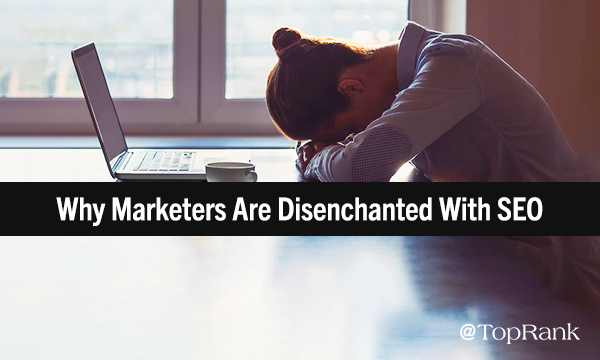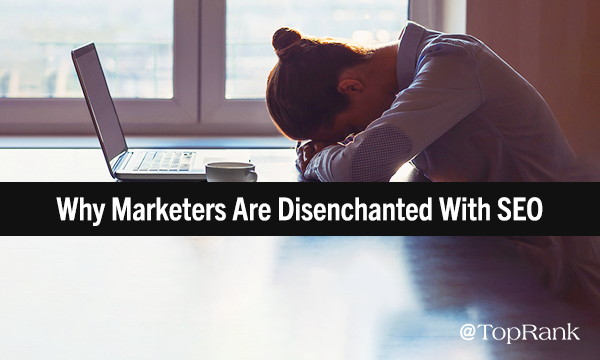
Just over two decades ago, search engine optimization (SEO) burst onto the internet scene and kicked the digital marketing doors wide open. Today, marketers consider SEO an effective and required part of their digital marketing mix — well, some of us at least.
Many thought leaders, marketers, and brands have speculated that SEO is dead, but we’d argue that it most certainly isn’t. Rather, it’s being reborn. However, it appears to be fading as a core digital and content marketing strategy.
Why? There’s no one answer. Instead, multiple challenges and frustrations have fused to create disenchantment with the practice.
The Current Sitch
While HubSpot’s State of Inbound 2018 report indicates that 61% of marketers say improving SEO and growing their organic presence is their top inbound marketing priority, a recent survey from Clutch shows that SEO is the least popular digital marketing tactic, with just 44% of marketers leveraging SEO. (And just think of how many articles you’ve seen — including this one — pondering whether SEO is dead or alive.)
Now think about this: 91% of B2B marketers and 86% of B2C marketers use content marketing as part of their marketing strategies, according to Content Marketing Institute’s 2018 benchmarking studies.
Setting aside the different methodologies and sample groups used for these reports, I think we can all agree that some marketers are struggling to see the value of SEO (and many may even be missing its important connection to content marketing).
*Cue the dramatic music.*
But why are marketers shying away from this foundational digital marketing tactic?
The Modern Marketer’s SEO Struggle
It’s a Dog Eat Dog World
We’ve all heard (and maybe said) the top complaint: Thanks to high content marketing adoption, the organic search landscape has become too [expletive] crowded. And as a result, many marketers feel they can’t effectively compete.
As a result, more marketers are forgoing the long-term play and turning to paid search to get top placement in SERPs. In fact, paid content promotion has increased almost 400% since 2014, according to a survey from Orbit Media.
Furthermore, digital marketing budgets are slowly growing. According to August 2018 CMOsurvey results, in the next five years, digital marketing spending is expected to overtake the majority of marketing budget spend, rising from 44% to 54%.
To us, this not only signals that marketers feel the required SEO effort is too taxing and competitive, but also that they’re under increasing pressure to deliver fast results. And with larger budgets to allocate to digital, marketers may be looking to other options that can show results more quickly.
It’s Not Black and White
Since its inception, Google has been constantly leveling up the sophistication of its ranking algorithm — much to the dismay of marketers. In fact, just this summer there were several Google updates such as mobile site speed and HTTPS, all of which had SEO and ranking implications.
Savvy marketers have been paying attention to these updates. They understand that while Google will never divulge its full ranking algorithm, there are key ranking factors such as relevant, user-friendly content and quality backlinks that are important for SEO and user experience. And they know content optimization requires tweaking and testing to see what works for them.
However, with so much on their plates, the fast paced change is hard to keep up with. And couple this with the content saturation mentality, SEO can feel like a losing battle.
It’s a Waiting Game
When black-hat tactics went extinct, marketers had to get used to the notion that SEO was the long-play. But that doesn’t mean they’ve been happy with the waiting game, especially if other tactics have the potential to work more quickly.
But marketers aren’t the only ones who want fast results — so does the C-suite. And if marketers don’t deliver, they sow seeds of doubt and stand to disappoint executives, who are likely the ones who approve their budgets.
And, of course, hearing phrases like “Rome wasn’t built in a day” or “It’s a marathon, not a sprint” adds to the frustration — and doesn’t quell pressure from higher-ups.
Our Hot Take: Now Is Not The Time to Quit
The changing and challenging search landscape is frustrating. There are trillions of unique web pages and counting to compete with. Algorithms and search styles are constantly evolving. And, to top it all off, you’re under pressure drive results and meet internal stakeholder expectations. We get it.
But here’s the thing all marketers should remember: Change is inevitable. Our world is increasingly digital, which means the digital marketing landscape will continue to experience rapid shifts.
Also, many of the changes and challenges you’re experiencing now aren’t new. “Easy win” or black-hat SEO tactics have been dead and gone for a while now, and Google has been tweaking algorithms on the daily for a decade or more. Furthermore, content marketing is closing in on a decade of growing use—and shows all the right signs to continue as a staple digital tactic.
So, rather than abandoning a tried-and-true tactic, perhaps it’s time to shift your strategy. As founder of SparkToro and Moz, and one of SEO’s most recognizable experts, Rand Fishkin once said:
“SEO is powerful precisely because it’s hard to predict and hard to measure.”
So, it’s not a matter of “can” you get results with SEO, it’s a matter of “how” you’ll adapt to find success.
We know quality content that matches search intent is a key ranking factor. And we also know quality backlinks are important, too. So, how do you create link-worthy content? Check out our post featuring five types of link-worthy content.



